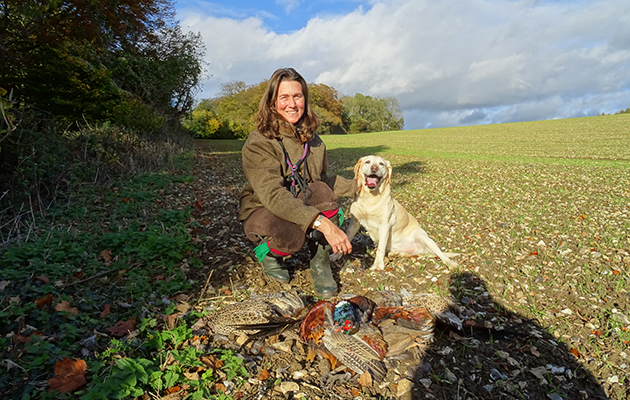A love for our environment and fieldsports – both here and abroad – is underpinned by a firm belief in the ‘field to fork’ principle for Lucinda Sutcliffe
From joining the beating line aged six to pursuing sport all over the world, for Lucinda Sutcliffe, her passion for fieldsports is firmly underpinned by a ‘field to fork’ philosophy.
For more sporting Dianas, seriously sporting ladies offering advice and encouragement, Victoria Maloch is following academic and professional paths to represent rural interests in the policy making process. And Tiggy Pettifer is a fundraiser for the Atlantic Salmon Trust and works to inspire the next generation.
LUCINDA SUTCLIFFE
The shooting rights at Boughton Estate were under the helm of my maternal grandfather when, aged six, I joined the beating line made up of jovial steelworkers from nearby Corby. Fed up with frozen feet on stop for half a crown, I commandeered our labrador and turned him into a half-decent retriever so I could stay warm. My father, who would buzz off shooting in his helicopter with my mother and dog, first picked up a gun with his father post–World War II whilst living in Iraq, honing his skills on sand grouse and partridges, always for the table.
In the Ruhr during the war, my grandfather, Master of the Old Berkeley Beagles, met a like-minded American who had his own pack of foxhounds and beagles. Invited to stay at their Florida plantation, our day dawned with a morning duck flight or beagling, followed by quail hunting on horseback over pointers, a dove hunt, then chasing nocturnal raccoons up trees with bloodhounds – a bonus not getting muddled up with an alligator. If this was heaven, I wanted in quickly.

Her passions include a lifelong love of breeding gundogs.
I hunted scruffy ponies alongside my mother with the Vale of Aylesbury, and have since followed staghounds on Exmoor, buckhounds and multiple foxhound packs, including the Iroquois Hunt in Kentucky. Keen to give something back to hunting, I was clerk of the course at Kimble point-to-point for seven years.
Following agricultural college I groomed polo ponies at Wallabadah in New South Wales, Australia, and kept my team sharp mustering sheep and cattle on the station. I practised on kangaroos, too. Next stop, Kentucky: bourbon, tobacco or thoroughbreds. Rude not to embrace all three. For light relief during the Keeneland yearling sales I was cajoled into joining a dove shoot. With the wild birds swooping in to feed on the sunflower fields, humid, 90-degree heat ensured that hot barrels kept swinging and the 20-bird state limit was attained and retrieved with an incentive of cold beer and barbecued dove. I was captivated. Two years later I came home to a seven-month-old, short-legged black labrador bred by my mother, Kangaroo, initiating a lifelong love of breeding gundogs.
A PERFECT STORM
My bloodstock business gave me the liberty to raise children alongside several litters of labradors, a perfect storm. Flying out to Kentucky on business, my luggage included three labrador puppies and a beagle for our old American friends. I juggled work with my team, picking up 60 days a season with homebred/trained dogs. Not needing to pull the trigger, I’ve taken enormous pleasure watching great shots or a novice’s first day. Inevitably encouraged, my children learnt to shoot from age 10.
When I upped sticks to live on the top of the North Yorkshire Moors, I discovered a true sense of inner peace – also grouse in the garden, curlew, August heather, snow. The interaction and sense of community amongst the local people when running a shoot was awe-inspiring, though not without its challenges. A twist of fate led me to pick up, flank and shoot at some iconic North Yorkshire shoots, as well as English partridges in the Borders.
At this time I was introduced to wildfowling on Loch Leven, home to 15,000 migratory pink-foot and Canada geese, tufted duck and goldeneye, among others, and the indigenous brown trout, Salmo levenensis, which we fished from boats.
Wild-bird shooting remains my passion, out by boat in the dark, the humming of geese revving up to leave for land by day and witnessing a new dawn from an island or shoreline as the misty loch comes alive with wildfowl. Or the evening flight, zig-zag skeins of geese turning the sky black; whistling teal like arrows coming in to feed. Wrapped against the weathers, often waist high in water, this is not for the faint hearted but to not be there is to miss out on nature’s way and, with my hunter-gatherer instinct, hopefully bring home dinner. Not everyone has witnessed a woodcock crossing the moon as its light casts a runway across the loch towards you – etched in my memory.
Our sport’s future lies in encouraging and educating the younger generations about life in the field. In this rapidly evolving world, they hold us to account for our actions and society today does not necessarily view our country sports as a given right. For longevity we must ensure the conservation that takes place in hand with the sport is acknowledged and understood to be vital to the functioning of our ecosystem.
TOP TIPS: Follow your instincts and remember we are the custodians of our environment. It will take hard graft and a sincere love of, and duty to, this natural world to ensure the survival of our sports. Carry others along with you, the rewards are heartfelt and worth it. And remember: field to fork.
Lucinda Sutcliffe is PA to the managing director of EJ Churchill Ltd





